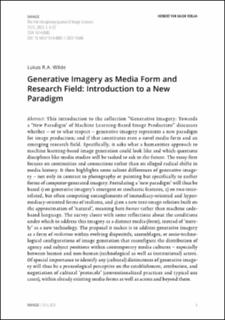| dc.contributor.author | Wilde, Lukas R.A. | |
| dc.date.accessioned | 2023-10-18T14:14:40Z | |
| dc.date.available | 2023-10-18T14:14:40Z | |
| dc.date.created | 2023-10-17T12:26:04Z | |
| dc.date.issued | 2023 | |
| dc.identifier.citation | IMAGE: The Interdisciplinary Journal of Image Sciences. 2023, 37 (1), 6-33. | en_US |
| dc.identifier.issn | 2362-4981 | |
| dc.identifier.uri | https://hdl.handle.net/11250/3097331 | |
| dc.description.abstract | This introduction to the collection “Generative Imagery: Towards a ‘New Paradigm’ of Machine Learning-Based Image Production” discusses whether – or to what respect – generative imagery represents a new paradigm for image production; and if that constitutes even a novel media form and an emerging research field. Specifically, it asks what a humanities approach to machine learning-based image generation could look like and which questions disciplines like media studies will be tasked to ask in the future. The essay first focuses on continuities and connections rather than on alleged radical shifts in media history. It then highlights some salient differences of generative imagery – not only in contrast to photography or painting but specifically to earlier forms of computer-generated imagery. Postulating a ‘new paradigm’ will thus be based 1) on generative imagery’s emergent or stochastic features, 2) on two interrelated, but often competing entanglements of immediacy-oriented and hypermediacy-oriented forms of realisms, and 3) on a new text-image-relation built on the approximation of ‘natural’, meaning here human rather than machine code-based language. The survey closes with some reflections about the conditions under which to address this imagery as a distinct media (form), instead of ‘merely’ as a new technology. The proposal it makes is to address generative imagery as a form of mediation within evolving dispositifs, assemblages, or socio-technological configurations of image generation that reconfigure the distribution of agency and subject positions within contemporary media cultures – especially between human and non-human (technological as well as institutional) actors. Of special importance to identify any (cultural) distinctness of generative imagery will thus be a praxeological perceptive on the establishment, attribution, and negotiation of cultural ‘protocols’ (conventionalized practices and typical use cases), within already existing media forms as well as across and beyond them | en_US |
| dc.language.iso | eng | en_US |
| dc.publisher | Herbert von Halem Verlag | en_US |
| dc.rights | Navngivelse 4.0 Internasjonal | * |
| dc.rights.uri | http://creativecommons.org/licenses/by/4.0/deed.no | * |
| dc.title | Generative Imagery as Media Form and Research Field: Introduction to a New Paradigm | en_US |
| dc.title.alternative | Generative Imagery as Media Form and Research Field: Introduction to a New Paradigm | en_US |
| dc.type | Journal article | en_US |
| dc.description.version | publishedVersion | en_US |
| dc.source.pagenumber | 6-33 | en_US |
| dc.source.volume | 37 | en_US |
| dc.source.journal | IMAGE: The Interdisciplinary Journal of Image Sciences | en_US |
| dc.source.issue | 1 | en_US |
| dc.identifier.doi | https://doi.org/10.1453/1614-0885-1-2023-15446 | |
| dc.identifier.cristin | 2185530 | |
| cristin.ispublished | true | |
| cristin.fulltext | original | |

